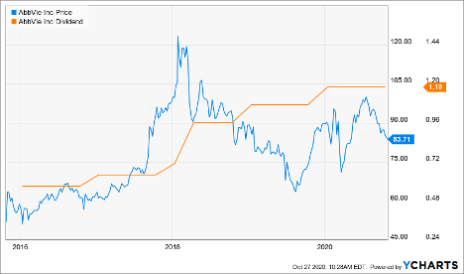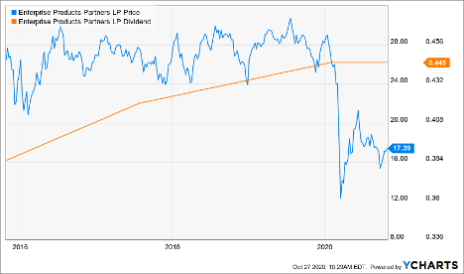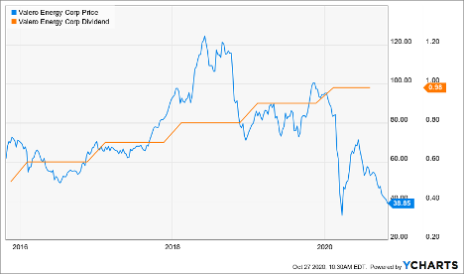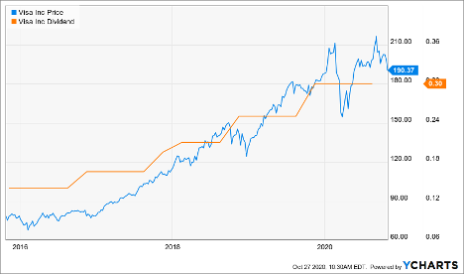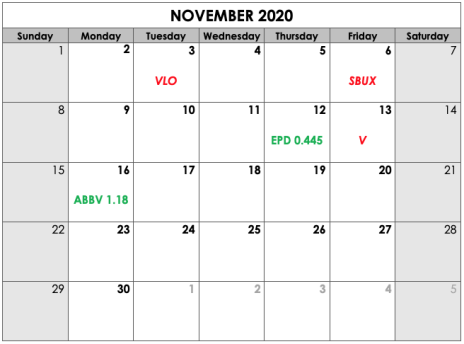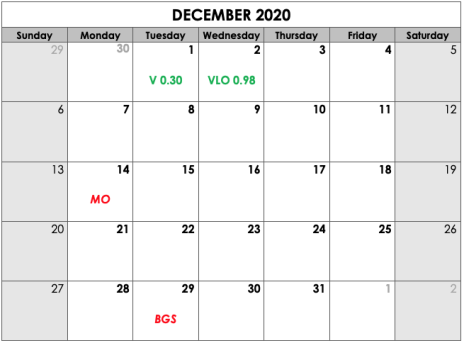These are crazy times. This pandemic-riddled year isn’t done with us yet. In fact, Covid cases are rising and many states are reinstating new batches of lockdown restrictions. At the same time, we’re less than a week away from an election with a high risk of a contested result and the ensuing uncertainty.
At some point, we will get past the election and the pandemic. The economy should boom and the market will be free to rise. But things could still get awfully dicey in the weeks and months before we get to the Promised Land.
In this issue, I highlight a high-income stock that is ideal for the current situation. The business is benefitting mightily from the pandemic. It’s a defensive stock that should continue to perform well amidst the volatility. Yet, it should also be a star in the post-pandemic market.
Not only does this stock pay a high dividend, but it attracts high call premiums as well. It is one of the very few stocks that is well worth buying in the current situation.
Cabot Income Advisor 1020
[premium_html_toc post_id="218697"]
A Perfect Stock for this Wacky Environment
This is a tricky market, to say the least.
It’s earnings season. Earnings are always a wild card, no matter what you think you know about a company. You never know what a company will report of what they’ll say, or how the market will react. But this is no ordinary earnings season.
There is a presidential election less than a week away. And this is no ordinary election. The parties are very far apart, and the policies pursued are vastly different. We don’t even know in which general direction the country will be led in the months and years ahead.
Historically, the market doesn’t much care who wins, at least at first. The market tends to be driven much more by the economic cycle than politics. And the economy is trending upward at a fast pace. But this election could be different.
Many are predicting that the election may not even be decided on Election Day because of delays from mail-in voting. There is a strong possibility of a contested result. Uncertainty could drag on for weeks or months. The market won’t like that.
And this is in the midst of no ordinary year. The country and world continue to grapple with this pandemic. There is still no vaccine and virus cases are increasing. Many states are implementing stricter measures once again. On Monday, the market had the worst one-day selloff in months on renewed virus fears.
But I believe in the recovery. The U.S. economy tends to be more resilient that it ever gets credit for. And I believe that the recovery will exceed expectations in the months ahead. The election and the pandemic will fade into the rearview mirror. And the bull market should take off.
But things could get dicey before we get to the Promised Land. It’s anybody’s guess what will happen and how the market will react in the weeks ahead.
Because of uncertainty regarding the election and the virus, investors are less willing to bet on higher prices in the near future. As a result, the call premiums are lower. At the same time, stock prices are still relatively high and there aren’t many bargains out there.
Nevertheless, I found one stock that is actually ideal for the current environment.
It has a defensive business that is thriving in the pandemic. It yields a stellar 6.75%. Although the stock has performed very well this year, it still sells at a historically low valuation. And it should perform extremely well in the post pandemic environment as well.
What to Do Now
Several portfolio positions on which covered calls were written exceeded the strike price on options expiration and were likely called away. These stocks include IIPR, QCOM, USB, SBUX and BIP. This happens in an up market. You were rewarded for your troubles will a high income return from capital appreciation as well as the call premium and dividends.
The purpose of the newsletter is to sacrifice potential capital appreciation for a higher income return. Remember, there is no profit until it is realized. Unless you sell the stock, that profit could easily evaporate, especially in the current environment. The strategy not only provides a high level of current income, but also a high total return that often beats the market return.
In this market, stocks that are working continue to work. And stocks that haven’t worked continue to underperform. Most of the stocks remaining in the portfolio represent the latter.
The energy stocks (EPD and VLO) as well as MO and ABBV have continued to underperform. But the upcoming earnings announcements as well as a resolution to the election should get at least of few of these stocks moving in the right direction, and create covered call writing opportunities.
There is currently only one outstanding covered call in the portfolio. This is unusual. And it won’t last. Please be on the lookout for “Special Alerts” in your email. The situation can change fast in this headline-driven market. Opportunities to write calls on several positions could materialize in the days and weeks ahead. As well, down-market volatility could create great buying opportunities for certain stocks.
Monthly Recap
September 22
Purchase – Visa Inc. (V) – 200.56
September 30
Sell V Nov 20 $200 call at $10.00 or higher
October 16
Expired in-the-money - SBUX October 16 $87.50 call at $3.30
Expired in-the-money - BIP October 16 $45 call at $1.95
Both positions in Starbucks (SBUX) and Brookfield Infrastructure Partners (BIP) exceeded the strike price on expiration day and were likely called away. SBUX is currently selling at about 2.50 above the strike price and BIP has since moved slightly below the strike price.
A Changing Portfolio
As I mentioned earlier, several of the portfolio positions have been called away as the prices exceeded the strike price at the time of expiration. This is very normal and it will happen in a market that moves rapidly higher.
That’s fine. We can always buy those and other stocks back later. In the meantime, you lock in a high income and get some capital appreciation for your trouble. The recently called stocks provided total returns of 10.2% and 13.1% in a relatively short amount of time.
The current portfolio is unusually barren. Stocks that were called away have not been replaced as the market hasn’t offered many bargains. And the growing uncertainty makes it less prudent to chase higher price stocks. At the same time, the recent uncertainty and downside volatility has dried up the call premiums and there are fewer opportunities temporarily.
Expect this portfolio to vary between having a lot of activity and a little. You have to take what the market gives you and not try to force things. That’s the nature of an income portfolio. There are times when covered call premiums are high and periods when they are not. It can be a feast or famine situation. But, rest assured, there will be many opportunities over the course of the year.
Featured Action
B&G Foods, Inc. (BGS)
New Jersey-based B&G Foods is an American food manufacturer that sells familiar shelf-stable and frozen foods in the U.S., Canada and Puerto Rico. In business since 1889, the company sells 50 well-known and popular food brands including Cream of Wheat, Green Giant Vegetables, Ortega, Dash, Accent, Crock-Pot and others.
As a seller of food, the ultimate consumer staple, the company has been able to generate stable earnings from which to pay a generous dividend. And a high paying, defensive company it was. The food company has consistently maintained and raised the dividend since its IPO in 2007. And that yield is currently 6.75%, although it has been much higher in recent years.
But the dividend was about all it offered of late, and some worried whether it could be maintained. B&G struggled to grow earnings. Over the past five years, the company averaged earnings growth of just 3%. The stock price continued to deteriorate, from over 50 per share in mid 2016 to under 20 by the beginning of 2020.
But the coronavirus changed everything.
A New Paradigm
Business is booming at B&G. During the lockdown, people have been confined to their homes and eating there. Many are stocking up on nonperishable items as they want to limit visits to the store. The new trend is right in B&G’s wheelhouse. How big of an impact is this having?
In the second quarter, B&G reported year-over-year net sales growth of 38.1%, and adjusted EBITDA growth of 44.6%. Management has also stated that sales and earnings for the year will be significantly higher than previously anticipated. Analysts are expecting 31% year-over-year earnings growth.
Okay, so they’re killing it during the pandemic. What happens when it’s over? There is reason to believe the new habits will last. A recent survey conducted by investment firm Piper Jaffray found that 2/3 of respondents said they intended to eat at home more after the virus.
The survey also predicted a sustainable 15% lift in at-home food consumption. It suggests that, while the numbers we’re seeing during the lockdown will likely come down, a more permanent shift in food consumption is likely underway.
A Transformation
How have these improved fortunes affected the stock? BGS has returned over 64% YTD and over 88% over the past year. You may think you missed the boat. But the stock (currently 29 per share) is still well below the 50 level it hit in 2016, and with much better earnings. Despite vastly improving earnings and fundamentals, BGS still sells at valuation measures significantly below the five year averages.
This company and stock have changed. At the start of this year, this was a slow growth company struggling to maintain a dividend that was too high. Now, it is a much stronger growth company that is easily supporting the dividend. It’s now a safe, high-yielding defensive stock with significant growth prospects in the years ahead.
The company is feeling its oats too. It just acquired the world’s number one shortening and vegetable oil brand Crisco. The company estimates that the $550 million purchase will be immediately accretive to earnings. B&G sees a $270 million earnings boost and earnings per share of an additional $0.45 to $0.50 in 2021. That’s a significant bump from the trailing twelve month EPS of $1.77. The market likes the deal, as the stock is 4% higher the day after the announcement.
The defensive nature of the business makes this a good holding for the remaining uncertainty with the election and Covid. The high yield and strong growth should make it a winner in the post pandemic world.
B&G Foods, Inc. (BGS)
Security type: Common stock
Industry: Packaged Foods
Price: $28.94
52-week range: $10.39 - $31.93
Yield: 6.75%
Profile: B&G manufactures and sells 50 well know and popular brands of shelf-stable and frozen foods in the U.S., Canada and Puerto Rico.
Positives
- Earnings have soared during the pandemic as people are eating more at home.
- The trend toward eating home is likely to continue.
- B&G is undergoing rapid earnings growth, has a high and sustainable 6.75% yield, and sells at a reasonable valuation.
- The low beta stock should make this stock a good holding through market volatility.
Risks
- The stock did not perform well before the pandemic as slow growth and rising costs held back profits.
- There is no guarantee that the trend of more at home eating will persist beyond the pandemic.
- The company has to grapple with high debt and a high dividend payout.
Covered Calls
Sell SBUX October 16 $87.50 call at $3.30 – Expired and called
Total return 10.2%
$3.30 call premium
$5.09 capital appreciation (87.50 strike price minus 82.41 purchase price)
$8.39 total (return of 10.2% in less than 2 months)
Sell BIP October 16 $45 call at $1.95 or higher- Expired and called
Total return 13.1%
$0.485 dividend (Sept. 30)
$1.95 call premium
$3.08 capital appreciation (45 strike price minus 41.92 purchase price)
$5.51 total (income return of 13.1% in three and a half months)
V Nov 20 $200 call at $10.00 or higher
The stock has moved from over 200 all the way back down to about 190. The call premiums are now well below the $10 targeted price at $2.74. A big part of the reason for targeting a strike price very near the then-current stock price was a significant risk that the price could fall back in this uncertain market. We grabbed a fat premium on a stock that will surely come back strong if it continues to languish in the weeks ahead.
Portfolio Updates
AbbVie Inc. (ABBV)
Yield 5.6%
The stock is continuing to flounder. After a high of 100 in the summer, the stock has drifted to the current 84. Much of the performance has to do with the fact that the health care sector has performed poorly over that timeframe. It could be because of uncertainty of health care policies pursued by a potential Biden administration. However, given the defensive nature of the business and the tailwinds from the aging population, I believe the sector will continue to thrive after the election. AbbVie in particular has strong fundamentals as their new drugs and pipeline continue to perform very well. The company announces third quarter earnings on Friday and there is no reason not to expect solid results. But we’ll see. BUY
Altria (MO)
Yield 8.9%
The cigarette company also announces earnings on Friday. You never know what to expect but I believe it is more likely to be positive for the stock. This is a ridiculously undervalued stock that pays a massive and safe yield. It also has growth catalysts capable of offsetting the slippage in smoking volumes that the market isn’t factoring in. The yield alone should sustain this stock at a time when interest rates are at record lows. There is also a chance of decent appreciation in the months ahead. BUY
Enterprise Product Partners (EPD)
Yield 10.3%
This beleaguered midstream energy giant will announce earnings tomorrow. Since the earnings proved so resilient in the horrible second quarter, I’m expecting good things. And nothing good is factored into this stock price. Business will have most certainly picked up in the third quarter, with the likelihood of even better quarters ahead. But the stock might still not go anywhere until after the election.
A Trump win would probably be positive for the stock and the sector. A Biden win is likely already factored in. But I don’t think a less energy-friendly Biden Administration would be necessarily bad for EPD. This company did very well during the Obama Administration as new companies and projects faced the brunt of regulatory scrutiny and existing players benefitted. BUY
Valero Energy (VLO)
Yield 9.3%
Valero announced third-quarter earnings last week. As predicted, they were lousy. The company beat expectations but lost $1.14 per share. Its fast-growing renewable diesel business was a bright spot as sales grew nearly 300% over last year’s quarter. The refiner also intends to devote 40% of new projected spending on the renewable fuel. While margins for gasoline and diesel have come back strongly as the economy recovers, there was a huge inventory to work off. Going forward, Valero is likely to see rapid improvement in results. But, like EPD, VLO is unlikely to move much before the election. The stock has technical support at this level and is priced for a worst-case scenario. But even in the event of a Biden win, gasoline and diesel won’t go out of style anytime soon. And Valero should benefit as the uncertainty is eliminated. BUY
Visa (V)
Yield 0.6%
This payment processor stock has pulled back with the market. It was hovering in the low 200s when we wrote a call with a 200 strike price for November 20 expiration. The stock has moved down to 190. It also announces earnings tomorrow. Revisions have been moving higher, which is a good sign. But I have confidence in Visa regardless of how earnings turn out. It has 3.4 billion cards in circulation in 200 countries in a world that is increasingly moving away from cash transactions. The future of this stock is bright whatever happens in the near term. If the stock struggles in the weeks ahead, we keep the sizable call premium and keep the stock, and write more calls in the future. If it goes higher, we will still record a strong income return in a short time. BUY
Income Calendar
Ex-Dividend Dates are in RED and italics. Dividend Payments Dates are in GREEN. Confirmed dates are in bold, all other dates are estimated. See the Guide to Cabot Income Advisor for an explanation of how dates are estimated.
The next Cabot Income Advisor issue will be published on November 25, 2020.
Cabot Wealth Network
Publishing independent investment advice since 1970.
CEO & Chief Investment Strategist: Timothy Lutts
President & Publisher: Ed Coburn
176 North Street, PO Box 2049, Salem, MA 01970 USA
800-326-8826 | support@cabotwealth.com | CabotWealth.com
Copyright © 2020. All rights reserved. Copying or electronic transmission of this information is a violation of copyright law. For the protection of our subscribers, copyright violations will result in immediate termination of all subscriptions without refund. No Conflicts: Cabot Wealth Network exists to serve you, our readers. We derive 100% of our revenue, or close to it, from selling subscriptions to its publications. Neither Cabot Wealth Network nor our employees are compensated in any way by the companies whose stocks we recommend or providers of associated financial services. Disclaimer: Sources of information are believed to be reliable but they are not guaranteed to be complete or error-free. Recommendations, opinions or suggestions are given with the understanding that subscribers acting on information assume all risks involved. Buy/Sell Recommendations: All recommendations are made in regular issues or email alerts or updates and posted on the private subscriber web page. Performance: The performance of this portfolio is determined using the midpoint of the high and low on the day following the recommendation. Cabot’s policy is to sell any stock that shows a loss of 20% in a bull market or 15% in a bear market from the original purchase price, calculated using the current closing price. Subscribers should apply loss limits based on their own personal purchase prices.


